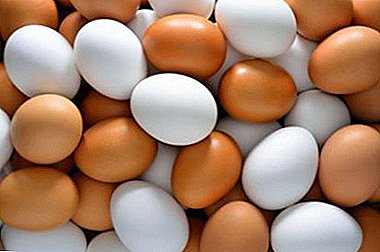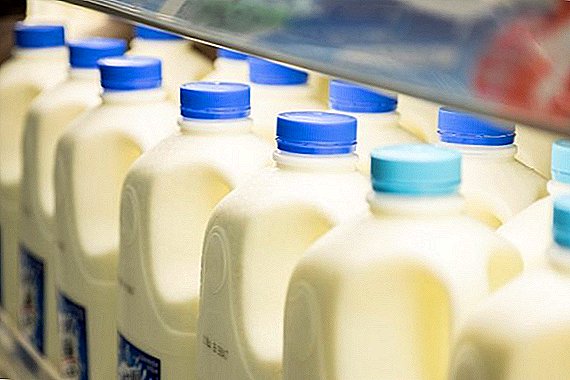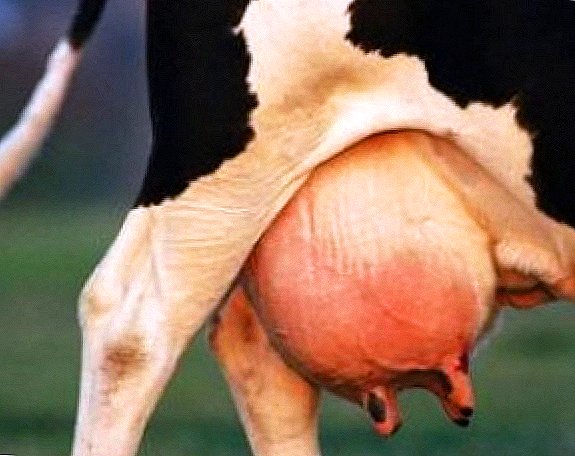
A cow’s udder is one of the most vulnerable parts of the body.
As an udder, you can determine whether the animal is healthy and how well it feels.
If the udder swells up, becomes too warm, or there are some other external changes on the face, then a veterinarian should be urgently called to make a conclusion about the general condition of the animal.
There is such a thing as udder swelling. Sometimes it is also called congestive or serous edema.
By edema is meant swelling of the udder due to a general disturbance of blood and lymph flow due to pregnancy or childbirth in an animal.
To a greater extent, those cows who fed mostly juicy and acidic feeds during the second half of pregnancy suffer from udder edema.
Udder can swell before giving birth in a few days or on the first day - two after the cow has given birth. The main cause of swelling is uneven blood circulation in the udder, that is, the blood flow is too much, and the outflow is too small.
What are the signs of the disease
It can swell like the entire udder as a whole, and only the back of it. The skin on the big udder thickens, then the structure resembles a dough.
If it is applied on the skin, then it will level out longer than usual.
The skin on the mammary gland is colder than the general temperature of the body; it shines, despite the tension, the cow does not feel any pain when it touches the udder. The nipples are the first to swell. They look shorter than the nipples that are not swollen. Further, the tension goes up through the subcutaneous tissue to the vulva, along the belly and reaches the breast bone.

Edema can also be observed in the area of one half of the udder or alternation, that is, the "transition" of edema from one side of the udder to the other.
Edematous fluid accumulates in the tissues of the udder, squeezing them. This is a violation of blood flow and lymph due to the increased load on the vessels, which leads to destabilization of the functioning and nutrition of tissues. Edema can cause mastitis or induction of the udder in a cow.
The overall temperature of the body, as well as the condition of the animal, may vary slightly. Also, edema does not have much effect on milkiness. The consistency of milk may be more liquid or not change at all.
The amount of milk produced may be slightly reduced due to poor circulation, but sometimes there is a paradox - the volume of milk from the healthy part of the udder may be less than the volume of milk from the part of the udder where there is swelling.
Edema may occur in a cow several days before giving birth, but after childbirth, the swelling subsides.

In any case, you can not leave this issue without attention. Despite the fact that swelling in the udder area before and after the birth of a cow is considered to be quite normal, edema can lead to a weakening of the resistance of the body and the udder tissue.
Also udder swelling is fraught with reduced breast stability to bacteria and other adverse environmental factors. And this can cause the development of mastitis.
Edema can be chronic. In this case, proliferation of connective tissue is observed, this process is called induction. The volume of the udder increases, and milk from this cow may receive a much smaller amount than before. Chronic edema can also cause mastitis.
It is also interesting to read about the disease of the hoofs of cows.
How to treat udder swelling
If the edema is postpartum in nature, then most likely, after 5 - 8 days after birth, the swelling will go away by itself.
If the udder is very swollen, it is necessary to take comprehensive measures.
During the treatment period the cow can not be fed a large number of succulent feed, you need to reduce the amount of concentrate for the animal, and not to give salt.
The diet should consist of high-quality hay. It is also necessary to milk this cow often, 7-8 times a day. The amount of fluid consumed should be monitored.

If the edema is stagnant, it is impossible to prevent the appearance of mechanical damage to the edematous part of the udder.
It is necessary to separate the animal from the rest of the cows, and also take it out for an hour’s walk 2–3 times a day.
Desirable massage udder from bottom to topwithout using any ointment, as with edema it is strictly forbidden to use them.
If you notice that the udder is swollen, and after a few days the cow must give birth to a calf, then the animal just needs to be milked once a day.
The main goal of udder edema treatment is to restore blood circulation and lymph circulation in the tissues of the udder, as well as to reduce the level of interstitial pressure. These goals can be achieved through frequent milking of the cow and massaging the udder.
From the point of view of medical treatment, the veterinarian can inject the cow gluconate or calcium chloride, as well as heart rate stimulants, which will contribute to more rapid removal of fluid from the body.
Also, doctors often prescribe special decongestants to the animals, as well as laxatives and diuretics.
To make the edema disappear more quickly, you can make a cow a poultice of hay dust, and also wrap the udder for heat concentration. If the udder has become too heavy and has dropped, then it must be tied up with a special bandage.
Prevention - do not allow edema

In order to prevent the appearance of edema in a pregnant cow, you need to organize daily exercise, give less succulent feed.
If the swelling has appeared, then juicy food in general should be excluded from the diet until the swelling subsides.
Special attention should be paid to the nutrition of a pregnant cow for one and a half to two weeks before giving birth, as well as for 10 to 14 days after.
So that edema does not cause the development of mastitis in a cow, it is necessary to comply with all sanitary standards so that the cow lives in clean conditions.
Do not allow sudden changes in temperature in the stall, and litter should be changed regularly.
Before you put the cows in a stall for the winter, the room must be thoroughly sanitized to kill all possible peddlers of the infection.

Also, to prevent udder edema, you need to milk the cow correctly.
At the slightest hint of udder swelling, you should immediately invite a veterinarian who will examine the cow and draw a conclusion.
Even if the alarm is false, you can take the necessary measures in time if necessary.












